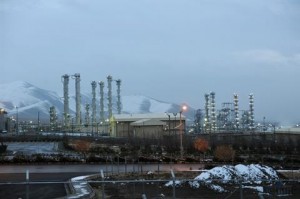
(Reuters) -�Iran�is trying to accelerate its uranium enrichment programme, a U.N. nuclear report showed, but experts said it was unclear when Tehran's new machines could start operating and how efficiently they would work.
The Islamic state's progress in introducing next-generation centrifuges is closely watched in the West and�Israel�as it would enable Tehran to speed up accumulation of material that could be used to build atomic bombs.�Iran�denies any such aim.
Iran�has tried for years to develop centrifuges more advanced than the erratic 1970s-vintage�IR-1 machines it�now runs, but deploying new models has been dogged by technical hurdles and difficulty in obtaining parts abroad.
It is now pressing ahead with installing a more efficient version known as the IR-2m at its main enrichment plant near the central town of Natanz, according to the report by the International Atomic Energy Agency (IAEA).
It has also put in place another centrifuge type, the IR-5, for the first time at a research and development facility at Natanz, joining five others being tested there, the report issued to member states late on Wednesday said.
The rapid installation of one of them, the IR-2m, at a Natanz production unit since it started earlier this year indicates that Iran can make such equipment, at least to some extent, despite tightening sanctions on the country.
Critics say Iran is trying to achieve the capability to make atomic arms. Iran denies this, saying it needs�nuclear power�for energy generation and medical purposes and that it is Israel's reputed nuclear arsenal that threatens regional peace.
The IAEA report said 509 IR-2m centrifuges and empty centrifuge casings had been installed since February, bringing the total to nearly 700, none of which were yet operating.
In addition, "preparatory installation work" has been completed for many more, it said. Centrifuges spin at supersonic speed to increase the fissile isotope in uranium.
Iran said in March it was building 3,000 next-generation centrifuges to produce low-enriched uranium to fuel�nuclear power�plants. But uranium can also provide the fissile core of a nuclear bomb if enriched to a high level.
INCOMPLETE CENTRIFUGE INFORMATION
If Iran can deploy that many, a "dangerous threat would develop" as the time needed for a nuclear bomb breakout bid would drop significantly, said Cliff Kupchan, a director and Middle East analyst at risk consultancy Eurasia Group.
"In addition, mastery of a faster machine would make use of a clandestine facility more attractive, as fewer machines and a smaller facility could be used to make a bomb," he said.
But Kupchan and other experts said it was not yet known whether Iran could obtain component materials for thousands of new centrifuges and how well they would work.
Whether Iran has "the resources or wherewithal" to deploy 3,000 IR-2m machines is unclear, said the Institute for Science and International Security (ISIS), a U.S. think-tank.
A Vienna-based diplomat familiar with Iran's nuclear programme said electrical and other connections were not yet in place, suggesting the launch of the IR-2m was not yet imminent.
The Arms Control Association, a research and advocacy group, said it was unlikely that Iran had been able to produce or procure the highest-grade materials for the new centrifuges.
Still, "experts assess that a tripling or quadrupling in efficiency might be realistic, but that it is difficult to estimate until the machines are operating", it added.
ISIS said the IAEA report did not specify how many of the IR-2m centrifuges contained rotor assemblies, which the think-tank said was the true measure of the numbers deployed.
"Thus, the information about the number of actual installed IR-2m centrifuges is highly incomplete," it said.
By Reuters
The Iran Project is not responsible for the content of quoted articles.










